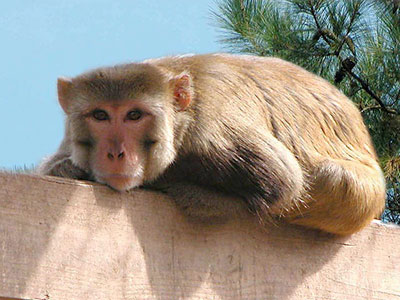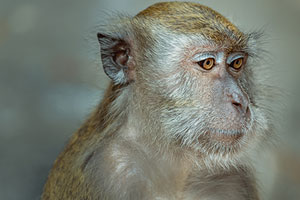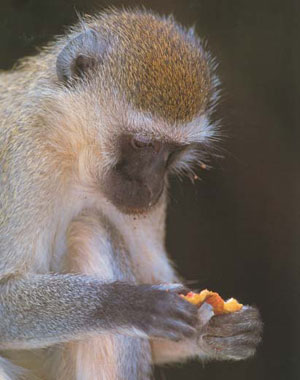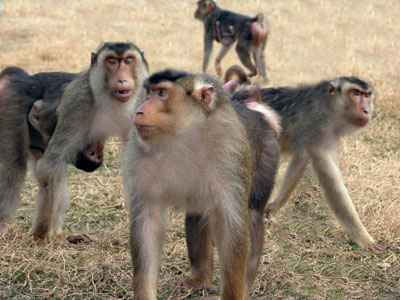Nonhuman Primates Species
We Study
Rhesus macaques (Macaca mulatta) are the most widespread nonhuman primate species. This is a diurnal, mostly terrestrial, and partly arboreal species. Rhesus macaques are placed within the Cercopithecidae family (Old World Monkeys).

Natural Habitat
- Afghanistan through much of India and Nepal, to northeastern China, Indochina, and Hainan
- Adapted to almost any ecological niche from sea level to ~8200 feet,
- from snow to intense heat, and from near desert situations to dense forests
Behavior
- Large multi-male/multi-female social groups (range from 10 to 180 or more individuals)
- Strong dominance hierarchy for both males and females
- Kinship is important in dominance with social status of the young dependent upon rank of their mother
- Females remain in the group in which they were born
- Males emigrate from their natal group at approximately 4 years of age
- Well known for their aggressive behavior
- Estimated to spend 10-13% of their daily activity on grooming
- Distinct breeding season
Diet
- Fruits, leaves, seeds, tubers, bark, insects
- Estimated that up to 92 plant species used by wild populations
Dimensions and Natural History
- Adults weigh from 9 to 22 lbs
- Males are larger than females
- May live up to 30 years in captivity
- Females sexually mature at 3.5 years, but growth not complete until 6th year
- Males sexually mature at 4.5 years, but growth not complete until 10th year
- Average gestation length is 165 days
Cynomolgus macaques (Macaca fascicularis) are also called long-tailed or crab-eating macaques.They live in much wetter habitats than rhesus or pigtailed macaques. Cynomolgus macaques are placed within the Cercopithecidae family (Old World Monkeys).

Natural Habitat
- Southern Indochina, Burma (Myanmar), Indonesia, Philippines, Nicobar Islands (part of India)
- Coastal, mangrove, swamp, and riverine forest
Behavior
- Multi-male/multi-female social groups (10 to 48 or more individuals)
- Groups may split into subgroups and come back together (fission-fusion)
- Males emigrate from their natal group around 4 years of age
- No distinct breeding season, so give birth all year round
- Swim well
Diet
Fruit, seeds, leaves, buds, insects, frogs, crabs
Dimensions and Natural History
- Adults weigh from 6 to 18 lbs
- Males are larger than females
- May live over 30 years in captivity
- Gestation length is 160 to 170 days
African Green monkeys (Chlorocebus genus) are the most widespread of all African monkey species.They are also called savanna guenons, grivets, vervets, or Tantalus monkeys.Green monkeys are placed within the Cercopithecidae family (Old World Monkeys).

Natural Habitat
- Senegal to the Sudan and Ethiopia and southwards to South Africa
- Savanna, open woodland, gallery, rainforest edge, riverine woodland
Behavior
- Multi-male/multi-female groups of 5 to 76 individuals
- Strong dominance hierarchy
- Males emigrate and join groups with relatives or known individuals from their natal group
- Females remain in their natal group
- Sleep in trees at night
- Have elaborate vocal communication system including different warning calls for different types of predators
Diet
- Omnivorous - fruit, seeds, savanna grass, gums, Acacia thorns and bark, insects, birds' eggs, small vertebrates
- Raid crops
Dimensions and Natural History
- Adults weigh from 7 to 15 lbs
- May live over 30 years in captivity
- Females are sexually mature at 4.5 years but do not have their first offspring until they are 5 years of age
- Males reach sexual maturity at 5 years
- Average gestation length is 165 days
Pigtailed macaques (Macaca nemestrina) are a diurnal species which is more arboreal than rhesus macaques.They spend an estimated 90% of their time in the forest canopy.Pigtailed macaques are placed within the Cercopithecidae family (Old World Monkeys).

Natural Habitat
- Burma to Malay Peninsula and Sumatra
- Lowland forests and coastal, swamp, dry land, and montane forest
Behavior
- Multi-male/multi-female social groups (15-40 animals)
- Matrilineal dominance hierarchy
- Males emigrate from their natal group
- No distinct breeding season, so give birth all year round
- The "pucker" is a unique facial expression with variable meanings depending upon the social context
Diet
- Fruit, seeds, leaves, flowers, insects, nestling birds, termites, river crabs
- Estimated more than 160 plant species used by wild populations
Dimensions and Natural History
- Adults weigh from 10 to 32 lbs
- Males are larger than females
- May live over 20 years in captivity
- Average gestation length is 174 days
